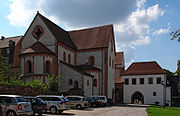
Wechselburg Priory
Encyclopedia

Wechselburg
Wechselburg is a municipality in the district of Mittelsachsen, in Saxony, Germany. It is well known for its twelfth century Benedictine monastery, theWechselburg Priory.- References :...
in Saxony
Saxony
The Free State of Saxony is a landlocked state of Germany, contingent with Brandenburg, Saxony Anhalt, Thuringia, Bavaria, the Czech Republic and Poland. It is the tenth-largest German state in area, with of Germany's sixteen states....
, dissolved in the 16th century and re-founded in 1993.
First foundation
Dedo V of WettinWettin (dynasty)
The House of Wettin is a dynasty of German counts, dukes, prince-electors and kings that once ruled the area of today's German states of Saxony, the Saxon part of Saxony-Anhalt, and Thuringia for more than 800 years...
founded the monastery, dedicated in 1168. Henry the Illustrious, Margrave of Meissen made a gift of it in 1278 to the Teutonic Order. In 1543 the abbey with all its possessions came into the hands of the territorial prince, Maurice, Elector of Saxony
Maurice, Elector of Saxony
Maurice was Duke and later Elector of Saxony. His clever manipulation of alliances and disputes gained the Albertine branch of the Wettin dynasty extensive lands and the electoral dignity....
. It was eventually dissolved in 1570.
Castle
After the Thirty Years' WarThirty Years' War
The Thirty Years' War was fought primarily in what is now Germany, and at various points involved most countries in Europe. It was one of the most destructive conflicts in European history....
(1618-48) the lords of Schönburg
Schönburg
Schönburg is a municipality in the Burgenlandkreis district, in Saxony-Anhalt, Germany. It is situated 5 km east of Naumburg, on the river Saale. It is part of the Verbandsgemeinde Wethautal....
built a Baroque
Baroque
The Baroque is a period and the style that used exaggerated motion and clear, easily interpreted detail to produce drama, tension, exuberance, and grandeur in sculpture, painting, literature, dance, and music...
castle (Schloss Wechselburg) on the foundations of the ruined abbey, which remained in the same family until their dispossession in 1945.
Second foundation
After the end of World War IIWorld War II
World War II, or the Second World War , was a global conflict lasting from 1939 to 1945, involving most of the world's nations—including all of the great powers—eventually forming two opposing military alliances: the Allies and the Axis...
the abbey church became the parish church and also a place of pilgrimage. In 1993 Benedictine monks from Ettal Abbey
Ettal Abbey
Ettal Abbey is a Benedictine monastery in the village of Ettal close to Oberammergau and Garmisch-Partenkirchen in Bavaria, Germany. With a community of more than 50 monks, with another five at Wechselburg, the Abbey is one of the largest Benedictine houses and is a major attraction for...
re-founded Wechselburg as a priory. Although the community is still small, they run a youth and family centre and are involved in pastoral care and managing the pilgrimages.
Because of its dependency on Ettal, Wechselburg is the only non-Bavarian monastery to be a member of the Bavarian Congregation
Bavarian Congregation
The Bavarian Congregation is a congregation of the Benedictine Confederation consisting of monasteries in Bavaria, Germany.It was founded on 26 August 1684 by the Blessed Pope Innocent XI .-First Congregation:...
of the Benedictine Confederation
Benedictine Confederation
The Benedictine Confederation of the Order of Saint Benedict is the international governing body of the Order of Saint Benedict.-Origin:...
.
Basilica
The RomanesqueRomanesque architecture
Romanesque architecture is an architectural style of Medieval Europe characterised by semi-circular arches. There is no consensus for the beginning date of the Romanesque architecture, with proposals ranging from the 6th to the 10th century. It developed in the 12th century into the Gothic style,...
basilica
Basilica
The Latin word basilica , was originally used to describe a Roman public building, usually located in the forum of a Roman town. Public basilicas began to appear in Hellenistic cities in the 2nd century BC.The term was also applied to buildings used for religious purposes...
of the Holy Cross remains as the parish church. It is famous for its huge and intricately carved mediaeval rood screen
Rood screen
The rood screen is a common feature in late medieval church architecture. It is typically an ornate partition between the chancel and nave, of more or less open tracery constructed of wood, stone, or wrought iron...
http://www.kloster-wechselburg.de/lettner.htm.
External links
Wechselburg Priory website----

